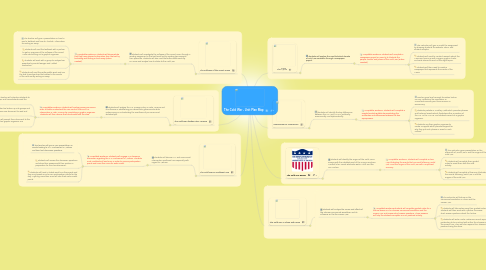
1. The Cold War in Southeast Asia
1.1. Students will discuss U.S. and Communist intervention Southeast Asia especially with regard to Vietnam.
1.1.1. Acceptable Evidence: Students will engage in a classroom discussion regarding the U.S. involvement in Vietnam. Students must contribute at least once in order to receive participation points and more than once for extra credit.
1.1.1.1. The teacher will give a mini-presentation on events leading to U.S. Involvement in Vietnam and hand out discussion questions.
1.1.1.2. Students will answer the discussion questions and share their answers with their partner in preparation for the class discussion.
1.1.1.3. Students will hand in tickets each time they speak and they must speak once to earn participation points for the day. Anything more than once will earn them extra credit points.
2. The Cold War divides Latin America
2.1. Students will analyze the U.S. Foreign Policy in Latin America and its influence in establishing pro-democratic governments while undermining or orchestrating the overthrow of pro-communist dictatorships.
2.1.1. Acceptable Evidence: Students will analyze primary sources in order to better understand the Iran-Contra Affair and U.S. Intervention in Latin America by completing a graphic organizer. Students will then discuss their documents with the class.
2.1.1.1. The teacher will introduce students to the topic and have students read the script.
2.1.1.2. Students will then be broken up into groups and each group will have one document to read and analyze.
2.1.1.3. Students will present their document to the class using their graphic organizer as a reference.
3. The Collapse of the Soviet Union
3.1. Students will investigate the collapse of the Soviet Union through a reading assignment in the text book and by reading two excerpts from speeches. Students will also read the Butter Battle Book by Dr. Seuss and analyze how it relates to the Cold War.
3.1.1. Acceptable Evidence: Students will demonstrate that they have gleaned information from the text by bucketing and writing a short essay (Rubric needed).
3.1.1.1. The teacher will give a presentation on how to read a textbook and how to "bucket" information for writing an essay.
3.1.1.2. Students will read the textbook with a partner to get an overview of the collapse of the Soviet Union while filling out a graphic organizer.
3.1.1.3. Students will work with a group to analyze two speeches by Ronald Reagan and Mikhail Gorbachev.
3.1.1.4. Students will read the Butter Battle Book and use the text to analyze how that relates to the events of the cold war by writing an essay.
4. Communism vs. Democracy
4.1. Students will identify the key differences between the U.S. and U.S.S.R. politically, economically, and diplomatically.
4.1.1. Acceptable Evidence: Students will complete a Popplet Double Bubble demonstrating the Similarities and differences between the two superpowers.
4.1.1.1. Teacher gives brief concept formation lecture on Key Vocabulary like Capitalism vs. Command Economy and Communism vs. Democracy.
4.1.1.2. Students partake in a Gallery Walk which provides phrases and historical events which illustrates either a position of the U.S. or the U.S.S.R. and students record on a graphic organizer.
4.1.1.3. Students use their graphic organizer to create a Popplet which provides support for why they put each phrase or event in each column.
5. The Cold War Begins
5.1. Students will identify the origins of the Cold War in Europe with the establishment of the Truman Doctrine, Marshall Plan, Soviet Blockade, Berlin Airlift, and the Iron Curtain.
5.1.1. Acceptable Evidence: Students will complete a Flow Map illustrating the events that occurred following World War II and the origins of the Cold War with 100 percent accuracy.
5.1.1.1. The Instructor gives presentation on the aftermath of World War II and the origins of the Cold War.
5.1.1.2. Students will complete their guided notes to assist them with the next activity.
5.1.1.3. Students will complete a flow map illustrating the events following World War II and the origins of the Cold War.
6. The Cold War in China and Korea
6.1. Students will analyze the causes and effects of the Chinese Communist Revolution and its influence on the the Korean War.
6.1.1. Acceptable Evidence:Students will complete guided notes for a lecture lesson on The Chinese Communist Revolution and the Korean War and answer short answer questions. These answers will help the students complete a RAFT postcard activity.
6.1.1.1. The instructor will lecture on the Communist Revolution in China and the Korean War.
6.1.1.2. Students will take notes using their guided notes. Students will then work with a partner to answer short answer questions about the lecture.
6.1.1.3. Students will write a Role-Audience-Format-Topic postcard pretending to be involved with either the Chinese Revolution or the Korean War. They will also respond to a classmates postcard using the same.
7. The 1960s
7.1. Students will analyze the most turbulent decade of Cold War escalation through a newspaper project.
7.1.1. Acceptable Evidence: Students will complete a Newspaper project on visua.ly to illustrate the people, events, and places of the Cold War. (Rubric Needed).
7.1.1.1. The instructor will give a model the assignment by showing students the website, rubric, and student samples.
7.1.1.2. Students will need to conduct research about the 1960s and come up with images, graphs, charts, and write stories for each of the eight topics.
7.1.1.3. Students will then need to create a newspaper that represents the events of the 1960s.
